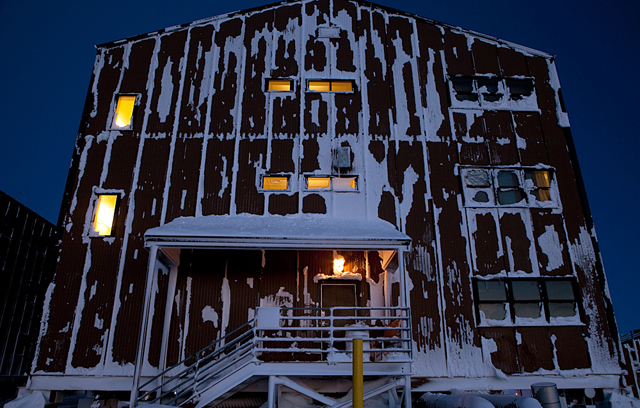McMurdo buriedStorms dump record amounts of snow at research station in AprilPosted May 8, 2009
A trio of storms in April blanketed McMurdo Station By May 1, some snow plowing was still ongoing nearly three weeks after the series of snow storms began. More than 6 feet of snow fell between April 11 and April 25. “We’re pretty much dug out. The roads are cleared,” said Gary Fromm, McMurdo Station winter site manager with Raytheon Polar Services More Information
You can find more photos from the storm and other images of life at McMurdo Station on Ken Klassy's Flickr page
The first storm began the evening of April 11 and dumped 17.5 inches over four days, including 14 inches in just 24 hours, a new record. The previous record had been 10 inches over a 24-hour period in April 1968, according to Ed Saul, a weather observer working at McMurdo for the winter. Temperatures dropped to about minus 15 degrees Celsius, with winds gusting at 78 knots and sustained winds of up to 55 knots. The heavy snowfall and wind caused long periods of almost zero visibility and immense snowdrifts throughout the station. The condition one storm largely shut down operations for 12 hours while it raged, Fromm said. The U.S. Antarctic Program Less than a week later, another powerful storm with similar winds dropped nearly 35 inches on McMurdo in just three days, with 20 inches coming in a 24-hour period, breaking the record again and doubling the old 41-year record high. A third storm followed close behind, adding more than 26 inches in four days, though with lesser winds. “Storms such as [these] are common during the change of seasons but can happen any time of the year,” Saul said. “Severe weather in April and August seems to come to mind. Weather can also be unsettled in September, October and February.” Pretty much the whole station, with a winter population of 153 people, pitched in to restore operations, Fromm said. “Fleet Ops did the bulk of the work with the heavy equipment, but people were out shoveling and running snow blowers and doing a lot of manual work.” Work also included repairing building roofs damaged in the storm, frozen pipes and restoring power. “We’re doing good,” Fromm said. “We’re back to order.” A team also drove out to Black Island, site of communications equipment across McMurdo Sound, to replace some solar panels that were lost to the wind and make other repairs. Wind gusts reached greater-than-hurricane strength at Black Island, with speeds clocked at 193 knots (211 mph) and sustained winds at 99 knots (114 mph). The all-time surface wind-speed record is 231 mph, recorded during an April windstorm in 1934 at the Mount Washington Observatory. “This was a pretty significant storm,” said Fromm, who grew up in cold and snowy Minnesota. |



For USAP Participants |
For The Public |
For Researchers and EducatorsContact UsU.S. National Science FoundationOffice of Polar Programs Geosciences Directorate 2415 Eisenhower Avenue, Suite W7100 Alexandria, VA 22314 Sign up for the NSF Office of Polar Programs newsletter and events. Feedback Form |




